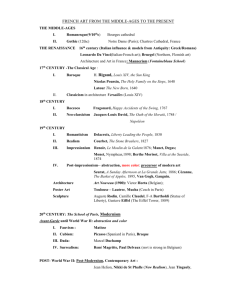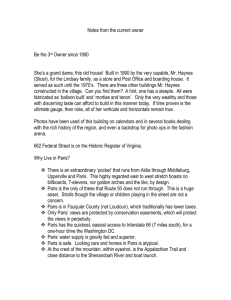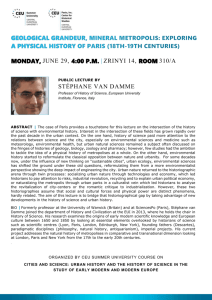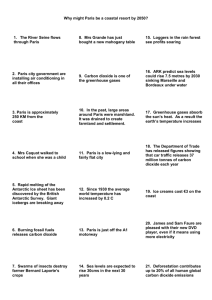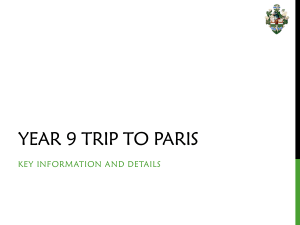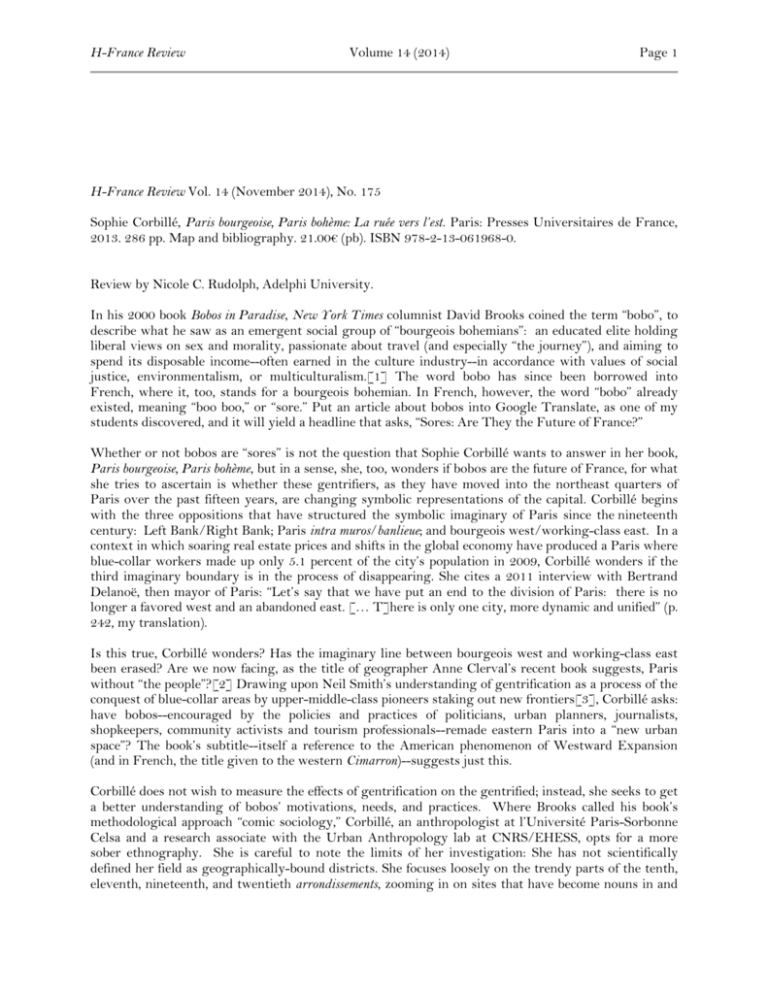
H-France Review
Volume 14 (2014)
Page 1
H-France Review Vol. 14 (November 2014), No. 175
Sophie Corbillé, Paris bourgeoise, Paris bohème: La ruée vers l’est. Paris: Presses Universitaires de France,
2013. 286 pp. Map and bibliography. 21.00€ (pb). ISBN 978-2-13-061968-0.
Review by Nicole C. Rudolph, Adelphi University.
In his 2000 book Bobos in Paradise, New York Times columnist David Brooks coined the term “bobo”, to
describe what he saw as an emergent social group of “bourgeois bohemians”: an educated elite holding
liberal views on sex and morality, passionate about travel (and especially “the journey”), and aiming to
spend its disposable income--often earned in the culture industry--in accordance with values of social
justice, environmentalism, or multiculturalism.[1] The word bobo has since been borrowed into
French, where it, too, stands for a bourgeois bohemian. In French, however, the word “bobo” already
existed, meaning “boo boo,” or “sore.” Put an article about bobos into Google Translate, as one of my
students discovered, and it will yield a headline that asks, “Sores: Are They the Future of France?”
Whether or not bobos are “sores” is not the question that Sophie Corbillé wants to answer in her book,
Paris bourgeoise, Paris bohème, but in a sense, she, too, wonders if bobos are the future of France, for what
she tries to ascertain is whether these gentrifiers, as they have moved into the northeast quarters of
Paris over the past fifteen years, are changing symbolic representations of the capital. Corbillé begins
with the three oppositions that have structured the symbolic imaginary of Paris since the nineteenth
century: Left Bank/Right Bank; Paris intra muros/banlieue; and bourgeois west/working-class east. In a
context in which soaring real estate prices and shifts in the global economy have produced a Paris where
blue-collar workers made up only 5.1 percent of the city’s population in 2009, Corbillé wonders if the
third imaginary boundary is in the process of disappearing. She cites a 2011 interview with Bertrand
Delanoë, then mayor of Paris: “Let’s say that we have put an end to the division of Paris: there is no
longer a favored west and an abandoned east. [… T]here is only one city, more dynamic and unified” (p.
242, my translation).
Is this true, Corbillé wonders? Has the imaginary line between bourgeois west and working-class east
been erased? Are we now facing, as the title of geographer Anne Clerval’s recent book suggests, Paris
without “the people”?[2] Drawing upon Neil Smith’s understanding of gentrification as a process of the
conquest of blue-collar areas by upper-middle-class pioneers staking out new frontiers[3], Corbillé asks:
have bobos--encouraged by the policies and practices of politicians, urban planners, journalists,
shopkeepers, community activists and tourism professionals--remade eastern Paris into a “new urban
space”? The book’s subtitle--itself a reference to the American phenomenon of Westward Expansion
(and in French, the title given to the western Cimarron)--suggests just this.
Corbillé does not wish to measure the effects of gentrification on the gentrified; instead, she seeks to get
a better understanding of bobos’ motivations, needs, and practices. Where Brooks called his book’s
methodological approach “comic sociology,” Corbillé, an anthropologist at l’Université Paris-Sorbonne
Celsa and a research associate with the Urban Anthropology lab at CNRS/EHESS, opts for a more
sober ethnography. She is careful to note the limits of her investigation: She has not scientifically
defined her field as geographically-bound districts. She focuses loosely on the trendy parts of the tenth,
eleventh, nineteenth, and twentieth arrondissements, zooming in on sites that have become nouns in and
H-France Review
Volume 14 (2014)
Page 2
of themselves: “Belleville,” “Oberkampf,” “Sainte-Marthe,” “Canal” (for Canal Saint-Martin) and
“Ménil.” She also acknowledges the poor definition of her object of study, noting that “bobos,” as a
category “at the intersection of several fields: journalism, marketing and sociology” (p. 101), are hard to
quantify. Moreover, they often don’t self-identify as such and can differ so much one from another that it
is impossible to consider them a social class en soi. Corbillé warns that she therefore has not sought
“representative samples.” Rather, as a resident of the eleventh arrondissement during the decade her
study covers (2000-2010), she opted for the method of participant observation, even as she recognizes
the problems of distance inherent in this approach.
Multiple questions guide her inquiry. Corbillé wonders why the bobos want to live in eastern Paris.
How do they represent this space to themselves? What are their residential, consumption, and leisure
habits, and how do these relate to urban space? How is the intense sociability that they value organized?
And if their presence makes a site “hip,” how does that affect Paris’s symbolic geography?
Inserting her study into the relatively recent literature in French invoking the term gentrification[4],
Corbillé identifies bobos as the new, largely upper-middle-class residents of working-class
neighborhoods and asserts that they play a key role in urban transformation. Using an “ethnography of
the familiar,” Corbillé interviews these gentrifiers to understand how they inhabit space, the meanings
they assign to their urban practices, their systems of interpretation and representation. These are the
people, Corbillé argues, who are building today’s Paris, a Paris that is also subject to the phenomena of
métropolisation and globalization.
Corbillé’s book is composed of fourteen chapters, divided into four parts. In the first section, she
discovers that bobos, in search of more space, or affordable space, cling to staying within the
péripherique, because they want to feel at the center of things, even if they never leave the four-block
radius of their own neighborhood. They are drawn to working-class neighborhoods, whose residents
include old-timers and recent immigrants, because they are seeking the authenticity and closeness
associated with “old Paris,” the Paris of Atget or Trenet, but also a twenty-first-century ethnic diversity.
The dominant trope becomes that of the “multicultural village,” where bobos can live among people
from different cultures, which lets them assert both their own individuality and their cosmopolitanism.
At the same time, the intimacy of these micro-neighborhoods allows the gentrifiers to feel at home, as
they have apéro with neighbors or exchange a few words with shopkeepers during their errands. Their
home interiors provide a backdrop for the eclecticism they cherish, combining high-end design with flea
market finds and exotic furnishings acquired while travelling or from a local shop.
The second section analyzes the practices of coexistence, which Corbillé asserts are based on friendly
exchanges (of food, expertise, or favors), neighborhood activism or community engagement, and
commercial transactions. This section is particularly strong, offering some of the most fascinating
observations of the book, as Corbillé unearths the ambivalence of the pioneers and their neighbors, as
well as the conflicts of values that may arise: the discomfort of a bobo mother, who brings a gift of
organic apple juice to a child’s birthday party, only to discover the children being served with all sorts
of candy and soda, or the transgressions of the “outside” sellers at the neighborhood sidewalk sale, who
refuse to make special deals for neighborhood residents, unaware that the meaning of jumble sales for
locals is primarily to reinforce neighborly ties. She also observes that neighborhood activism, organized
originally to protect or improve a neighborhood (making the streets safer, cleaning up litter) can evolve
into a protection of the neighborhood’s identity. Corbillé points to the former home of the Fraternal
Order of Metallurgists, the Maison des Métallos, which was purchased by the Mairie de Paris after
lobbying by neighborhood associations, who wished to save the building from private development and
argued that the space should be preserved as a monument to the city’s working-class patrimony.
Because part of the attraction of the northeast for the bobo is the opportunity to live in a diverse
neighborhood, Corbillé dedicates the third section to an interrogation of ethnicity, exoticism, and
H-France Review
Volume 14 (2014)
Page 3
otherness in these neighborhoods. Corbillé allows that the positive valorization of diversity coexists
with apprehension about or sometimes even fear of others, and she observes that new residents adopt
strategies for avoiding the street with the prostitutes or the corner where local youths hang out. Bobos
are also ambivalent about local schools, preferring to practice their coexistence with diversity through
eating ethnic foods or buying exotic goods. Further, Corbillé identifies the fragility of the ecosystem: if
a single ethnic group dominates in a neighborhood, the area ceases to be cosmopolitan; therefore the
traditional “small town” and the exotic “global” must be in balance. Bobos want to live in an urban
“village”, where they aren’t anonymous, but they also want to their neighbors to not solely consist of
people just like them; dwelling in a “multicultural village” works to reinforce their own individuality, as
well as their cosmopolitan identity.
In the final section of the book, Corbillé tries to bring the specificities of her study of bobos into a larger
frame, relating her subject’s production of space to the symbolism of two mythological Parises:
bourgeois Paris and bohemian Paris. She traces concerns about bourgeois inhabitants destroying the
“villages” of Paris back to the 1830s and the 1870s. In this sense, twenty-first-century articles worried
that bobos are destroying “authentic” Paris themselves comprise part of the construction of “Olde
Paris,” marking continuity of, not rupture in, this symbolic understanding of Paris. At the same time,
she notes that the importance of the symbolic capital accrued by being trendy or hip is a significant
factor in the production of space. The caipirinhas served at La Favela Chic link Paris to Brazil and the
Pink Flamingo’s pizzas invoke New York City, while both of these fashionable places contribute to
extending Paris’s borders by metonymy, linking Oberkampf and the Canal Saint-Martin to
Williamsburg in New York and Condesa in Mexico City. The bobo Parisian’s practices simultaneously
perform tradition--the authentic, popular Paris of the Maison des Métallos, a Belleville home to artists
and artisans--and modernity, engaged with the global market and and diverse constituencies. These
actions serve to differentiate Paris, enjoying global distinction, either for its novelty or for its long
history.
The strengths of this book are many. Sensitive to her subject, Corbillé paints her portrait of bobos with
nuance; largely sympathetic to the bobos, she relates their self-consciousness about being interlopers or
their ambivalence about their faux-industrial wine bars. She engages with the relevant literatures,
drawing upon Pierre Bourdieu to ground the choices bobos make in notions of social distinction,
invoking Marcel Mauss’s work on gifts when describing the function of exchange, and giving a nod to
David Harvey’s work on Paris and gentrification. That said, while Corbillé’s refusal to identify her
interviewees as a representative sample is understandable, some further information about how she
shaped her decade-long study would have been welcome. A number of the names--Gilles, Eric, Leila-appear several times; how many people did she interview exactly? Corbillé has a tendency to refer to
“numerous” or “several” when referring to actors’ choices, but what does that mean? And what about
counter-examples? Are there bobos who rejected the northeast when it came time to buy an apartment?
If so, why? Moreover, it is difficult to know just how unique the bobos of the northeast might be,
compared to say, the upper-middle-class residents of the fourteenth and fifteenth arrondissements. Do the
latter also like organic food shops? Do they, too, choose to stay in Paris because they wish to be in the
center of things? Non-anthropologists may feel better served by other, more quantitative studies. On
the other hand, Corbillé does bring other kinds of evidence (such as demographic studies, mass press
articles, policy documents) to bear upon her argument. One piece of evidence I found particularly
compelling was her use of a map of community gardens in Paris as a barometer to measure higher levels
of community interaction and engagement in the northeast (p. 140).
There are multiple insights to be gleaned on these pages, such as Corbillé’s assertion that even those
who attend council meetings for entertainment are performing local engagement (p. 139), or her
identification of the ways in which bobos treat diversity as a “condiment logic,” partaking of Vietnamese
cuisine here, and buying an African batik tablecloth there (p. 204). Yet, there are also moments when
Corbillé could push her analysis further. For example, when speaking of the “multicultural village,” she
H-France Review
Volume 14 (2014)
Page 4
raises a critique by Marie-Hélène Bacqué and Patrick Simon, who argue that the discourse of diversity
has serve to legitimize the conquest of working-class neighborhoods by the upper middle class and
public policymakers (p. 222). Rather than taking a position on this argument from her own vantage
point, Corbillé simply mentions it and then drops it, moving on to the next section.
Further, there seems to be some tension in the book between whether the object of study is bobos, or
the west-east boundary. The bulk of the research is dedicated to the former, but Corbillé’s argument
centers on the latter. If Corbillé wishes to make a case about changing understandings of the east/west
divide, it would be interesting to hear what the non-bobo residents of the northeast think. From time to
time throughout the book, we do hear from a few of these denizens: a local youth whose parents are
from Réunion and Tunisia, or two sisters who have lived in Oberkampf since the 1920s, but their
observations about the changes to the neighborhood are not analyzed for relevance to symbolic Paris.
Nevertheless, these observers do have their own understandings of the northeast’s status. As the young
man points out, the neighborhood kids of Belleville don’t want to stick around “the ghetto” when they
go out; they head off instead to Les Halles or to the Champs-Elysées (p. 162). According to the Robert
sisters, Oberkampf was “magnificent, grandiose”; now it gives them “the blues” (p. 157). This highlights
the difficulty of uniting the ethnographic work on the bobos’ representations and practices with the
larger points Corbillé wishes to make about the new urban space in the east and its connotations of
hipness.
In the end, Corbillé concludes that the west-east line stands. For one thing, the majority of intra muros
social housing is located in eastern Paris, guaranteeing a certain mixité for some time to come. On the
other hand, the boundary has assumed a new meaning, where the east now also signifies fashion,
diversity, cosmopolitanism, and authenticity. If Corbillé’s gentle treatment of bobos shies away from an
analysis of the harm that gentrification can do, she nonetheless offers a compelling explanation of how
the practices and representations of city dwellers contribute to cultivating the specificities of Paris.
Corbillé has written a thought-provoking account of the social production of the symbolic city.
NOTES
[1] David Brooks, Bobos in Paradise: The New Upper Class and How They Got There (New York: Simon &
Schuster, 2000).
[2] Anne Clerval, Paris sans le peuple: la gentrification de la capitale (Paris: La Découverte, 2013).
[3] Neil Smith, The New Urban Frontier: Gentrification and the Revanchist City (New York: Routledge,
1996).
[4] See, for example, the special issue of Sociétés Contemporaines 63(2006) on “Gentrification, discours et
politique,” featuring the work of Yankel Fijalkow and Marie-Hélène Bacque; Catherine BidouZachariasen and Jean-François Poltorak, “Le travail de gentrification: les transformations sociologiques
d’un quartier parisien populaire,” Espaces et sociétés 1132-1133(2008): 107-124; and multiple studies by
Anne Clerval.
Nicole C. Rudolph
Adelphi University
nrudolph@adelphi.edu
Copyright © 2014 by the Society for French Historical Studies, all rights reserved. The Society for
French Historical Studies permits the electronic distribution of individual reviews for nonprofit
H-France Review
Volume 14 (2014)
Page 5
educational purposes, provided that full and accurate credit is given to the author, the date of
publication, and the location of the review on the H-France website. The Society for French Historical
Studies reserves the right to withdraw the license for edistribution/republication of individual reviews
at any time and for any specific case. Neither bulk redistribution/ republication in electronic form of
more than five percent of the contents of H-France Review nor re-publication of any amount in print
form will be permitted without permission. For any other proposed uses, contact the Editor-in-Chief of
H-France. The views posted on H-France Review are not necessarily the views of the Society for
French Historical Studies.
ISSN 1553-9172



